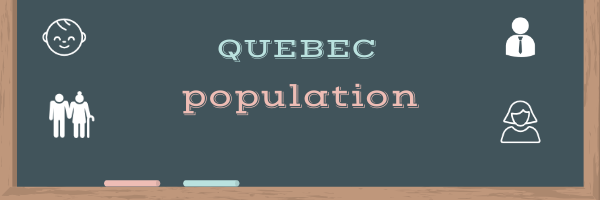
Quebec is the second most populated province in Canada with population around 8.4 million people. Quebec’s population account for 22.55 percent of the country’s population. It is home to second most populated city in Canada, Montreal. Quebec’s capital city is Quebec City which is also one of the top 10 biggest city in Canada. Quebec is one of the thirteen providences in Canada located in east side of Canada with area size of 1,356,625.27 km2.
Based on our research, Quebec population will reach 8,595,302 (around 8.6 million) by the end of 2024.The calculation is based on the average growth rate of 0.65% over last 12 years since 2011. We believe using the recent years’ figures (see the table in next section) will make the estimation more accurate. The estimation will adjust once Statistic Canada publishes census data.
Population Growth of Quebec
Looking back last twelve years of Quebec’s population, the growth rate is very consistent and strong ranging from 0.60% to 0.68%, adding around 50,202 to 55,490 people each year to the overall population. Lot of workers was moving to Quebec to take advantage of employment opportunities there, which contributes to the population growth. On the other hand, Quebec is a very popular city for immigrants. Quebec has recorded the strongest population growth in 2019 (0.68%).
Between census year of 2011 and 2016, Quebec’s population has increased 261,360 people or 3.31%.
| Year | Population | Growth Rate |
| 2011 | 7,903,001 | n/a |
| 2012 | 7,955,273 | 0.66% |
| 2013 | 8,007,753 | 0.66% |
| 2014 | 8,061,093 | 0.67% |
| 2015 | 8,113,073 | 0.64% |
| 2016 | 8,164,361 | 0.63% |
| 2017 | 8,217,121 | 0.65% |
| 2018 | 8,272,011 | 0.67% |
| 2019 | 8,327,501 | 0.68% |
| 2020 | 8,380,797 | 0.64% |
| 2021 | 8,432,658 | 0.62% |
| 2022 | 8,482,860 | 0.60% |
Demographics of Quebec
According to Canada census, Quebec is an extremely diverse city, with a huge number of ethnic and cultural groups living there. In 2016, most commonly ethnic origins include Haitian (2.5%), Arab (1.5%), Latin American (1.2%), Chinese (1.1%), South Asian (1.0%), Southeast Asian (0.7%).
In terms of language, according 2011 census, most spoken languages in Quebec are as follows: French (78%), English (7.7%), Arabic (2%), Spanish (1.8%), Italian (1.6%). Other spoken languages include Creoles (0.8%), Chinese (0.6%), Greek (0.5%), Portuguese (0.5%), Romanian (0.4%), Vietnamese (0.3%), and Russian (0.3%).
According 2001 census date, the religious makeup of Quebec is: 90.3 percent of the province population are Christian with 83.4 percent Catholic (including 83.2 percent Roman Catholic); 4.7 percent Protestant Christian (including 1.2 percent Anglican, 0.7 percent United Church; and 0.5 percent Baptist); 1.4 percent Orthodox Christian (including 0.7 percent Greek Orthodox); and 0.8 percent other Christian; Other religions include 1.5 percent Muslim; 1.3 percent Jewish; 0.6 percent Buddhist; 0.3 percent Hindu; and 0.1 percent Sikh. 5.8 percent of the population said they had no religious.
Population Density of Quebec
Quebec’s population density is 5.98 people per kilo square meter.
Most Populated Cities in Quebec
Based on 2016 Cesus data, here are the most populated cities in Quebec. Canadian Statistics classify them as population are which requires population greater than 1,000 and population density not less than 400 people per square km2. Montreal is by far has the most population compared with other cities in Quebec.
| Rank | City | 2016 Census |
| 1 | Montreal | 3,519,595 |
| 2 | Quebec City | 705,103 |
| 3 | Ottawa – Gatineau (Quebec part) | 276,245 |
| 4 | Sherbrooke | 139,565 |
| 5 | Trois-Rivières | 114,203 |
| 6 | Chicoutimi – Jonquière | 104,222 |
| 7 | Saint-Jean-sur-Richelieu | 84,685 |
| 8 | Saint-Jérôme | 77,146 |
| 9 | Châteauguay | 71,164 |
| 10 | Drummondville | 68,601 |
| 11 | Granby | 59,691 |
| 12 | Beloeil | 50,845 |
| 13 | Saint-Hyacinthe | 50,032 |
| 14 | Joliette | 45,508 |
| 15 | Victoriaville | 44,735 |
| 16 | Salaberry-de-Valleyfield | 39,048 |
| 17 | Shawinigan | 38,211 |
| 18 | Rimouski | 36,942 |
| 19 | Sorel | 36,088 |
| 20 | Saint-Georges | 26,921 |
Facts About Quebec
- Canada built a reservoir within the remnant of an ancient eroded meteor crater. Visible from space, it is known as “The Eye of Quebec”.
- The number of international adoptions in Quebec is the highest in all the canadian provinces.
- Under Quebec law, English is not an official language. The official language of this province is French. Approximately 80 % of the population speaks French as their native language and nearly 95% of Quebec speaks French as their native language.
- Quebec City is often referred to as the “Cradle of French Civilization in North America.” Walking in this part of Quebec City will make you feel like you are in Europe!
- Putin is a famous Canadian dish. You can find this recipe on the menu all over North America. But few people know that Poutine originated in the Quebec region.
- Canada produces 70 % of the world ‘s pure maple syrup. Of the 70%, 90 percent is from the province of Quebec.
- “Carnival,” the Quebec Winter Carnival, is one of the biggest winter festivals in the world.
- Every winter, Quebec City builds an ice castle and also uses it to jail people who are considered too glum during the holiday season.
References
The following links provide data for this topic:
- Statistics Canada: https://www12.statcan.gc.ca
- Government of Quebec: https://www.Quebec.ca
